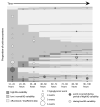Increasing blood glucose variability heralds hypoglycemia in the critically ill
- PMID: 21543086
- PMCID: PMC3154465
- DOI: 10.1016/j.jss.2011.03.008
Increasing blood glucose variability heralds hypoglycemia in the critically ill
Abstract
Background: Control of hyperglycemia improves outcomes, but increases the risk of hypoglycemia. Recent evidence suggests that blood glucose variability (BGV) is more closely associated with mortality than either isolated or mean BG. We hypothesized that differences in BGV over time are associated with hypoglycemia and can be utilized to estimate risk of hypoglycemia (<50 mg/dL).
Materials and methods: Patients treated with intravenous insulin in the Surgical Intensive Care Unit of a tertiary care center formed the retrospective cohort. Exclusion criteria included death within 24 h of admission. We describe BGV in patients over time and its temporal relationship to hypoglycemic events. The risk of hypoglycemia for each BG measurement was estimated in a multivariable regression model. Predictors were measures of BGV, infusions of dextrose and vasopressors, patient demographics, illness severity, and BG measurements.
Results: A total of 66,592 BG measurements were collected on 1392 patients. Hypoglycemia occurred in 154 patients (11.1%). Patient BGV fluctuated over time, and increased in the 24 h preceding a hypoglycemic event. In crude and adjusted analyses, higher BGV was positively associated with a hypoglycemia (OR 1.41, P < 0.001). Previous hypoglycemic events and time since previous BG measurement were also positively associated with hypoglycemic events. Severity of illness, vasopressor use, and diabetes were not independently associated with hypoglycemia.
Conclusions: BGV increases in the 24 h preceding hypoglycemia, and patients are at increased risk during periods of elevated BG variability. Prospective measurement of variability may identify periods of increased risk for hypoglycemia, and provide an opportunity to mitigate this risk.
Copyright © 2011 Elsevier Inc. All rights reserved.
Figures




Similar articles
-
Blood glucose response to rescue dextrose in hypoglycemic, critically ill patients receiving an insulin infusion.Ann Pharmacother. 2015 Aug;49(8):892-6. doi: 10.1177/1060028015585574. Epub 2015 May 18. Ann Pharmacother. 2015. PMID: 25986006
-
Improved safety with intravenous insulin therapy for critically ill patients with renal failure.Nutrition. 2014 May;30(5):557-62. doi: 10.1016/j.nut.2013.10.010. Epub 2013 Oct 22. Nutrition. 2014. PMID: 24296035
-
[The optimal blood glucose target in critically ill patient: comparison of two intensive insulin therapy protocols].Med Clin (Barc). 2014 Mar 4;142(5):192-9. doi: 10.1016/j.medcli.2012.11.032. Epub 2013 Mar 13. Med Clin (Barc). 2014. PMID: 23490488 Clinical Trial. Spanish.
-
Reducing glycemic variability in intensive care unit patients: a new therapeutic target?J Diabetes Sci Technol. 2009 Nov 1;3(6):1302-8. doi: 10.1177/193229680900300610. J Diabetes Sci Technol. 2009. PMID: 20144384 Free PMC article. Review.
-
Perioperative control of blood glucose level in cardiac surgery.Gen Thorac Cardiovasc Surg. 2013 Feb;61(2):61-6. doi: 10.1007/s11748-012-0198-9. Epub 2013 Jan 5. Gen Thorac Cardiovasc Surg. 2013. PMID: 23292688 Review.
Cited by
-
Insulin sensitivity in critically ill patients: are women more insulin resistant?Ann Intensive Care. 2021 Jan 21;11(1):12. doi: 10.1186/s13613-021-00807-7. Ann Intensive Care. 2021. PMID: 33475909 Free PMC article.
-
Continuous on-line glucose measurement by microdialysis in a central vein. A pilot study.Crit Care. 2013 May 11;17(3):R87. doi: 10.1186/cc12713. Crit Care. 2013. PMID: 23663747 Free PMC article.
-
Glycemic variability and glycemic control in the acutely ill cardiac patient.Heart Fail Clin. 2012 Oct;8(4):523-38. doi: 10.1016/j.hfc.2012.06.006. Epub 2012 Aug 9. Heart Fail Clin. 2012. PMID: 22999237 Free PMC article. Review.
-
Risk Factors of Intraoperative Dysglycemia in Elderly Surgical Patients.Int J Med Sci. 2019 May 10;16(5):665-674. doi: 10.7150/ijms.32971. eCollection 2019. Int J Med Sci. 2019. PMID: 31217734 Free PMC article.
-
What, why and how to monitor blood glucose in critically ill patients.World J Diabetes. 2023 May 15;14(5):528-538. doi: 10.4239/wjd.v14.i5.528. World J Diabetes. 2023. PMID: 37273246 Free PMC article. Review.
References
-
- Furnary AP. Diabetes, hyperglycemia, and the cardiac surgery patient: introduction. Semin Thorac Cardiovasc Surg. 2006;18(4):278–80. - PubMed
-
- Furnary AP, Wu Y. Clinical effects of hyperglycemia in the cardiac surgery population: the Portland Diabetic Project. Endocr Pract. 2006;12(Suppl 3):22–6. - PubMed
-
- Egi M, et al. Blood glucose concentration and outcome of critical illness: the impact of diabetes. Crit Care Med. 2008;36(8):2249–55. - PubMed
-
- Umpierrez GE, et al. Hyperglycemia: an independent marker of in-hospital mortality in patients with undiagnosed diabetes. J Clin Endocrinol Metab. 2002;87(3):978–82. - PubMed
Publication types
MeSH terms
Substances
Grants and funding
LinkOut - more resources
Full Text Sources
Medical

